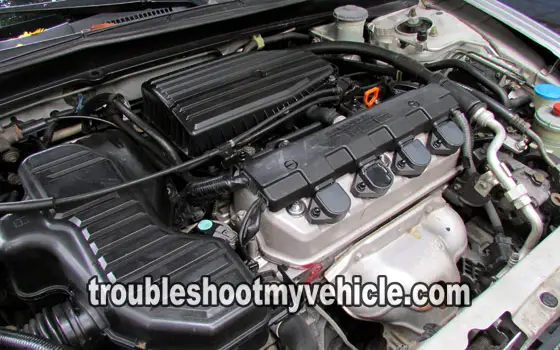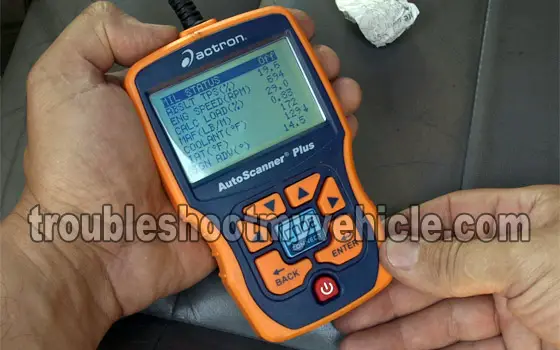
Sooner or later, your 1.7L equipped Honda Civic is going to experience a misfire condition and if it is already, don't despair, 'cause troubleshooting a misfire isn't all that hard.
That's right, it's not hard. There's a method to the madness of troubleshooting a misfire on your 1.7L Honda Civic.
In this article, I'll go into the basics of what causes a misfire condition and I'll also offer you a basic diagnostic strategy to get to the bottom of what's causing the misfire problem.
Contents of this tutorial:
ES ![]() You can find this tutorial in Spanish here: Cómo Probar Fallas En Encendido (2001-2005 1.7L Honda Civic) (at: autotecnico-online.com).
You can find this tutorial in Spanish here: Cómo Probar Fallas En Encendido (2001-2005 1.7L Honda Civic) (at: autotecnico-online.com).
APPLIES TO: This tutorial applies to the following vehicles:
- 1.7L Honda Civic (DX, EX, LX): 2001, 2002, 2003, 2004, 2005.
ENGINE NO-START DIAGNOSTICS:
What Is A Misfire Condition?
A misfire condition happens when one (or more) engine cylinders on your 4 cylinder Honda Civic are not producing power.
As you may already know, each of the 4 cylinders that make up the 1.7L engine in your Honda Civic need fuel, spark, and air (typically compression) to produce power.
When one (or more) of those 4 cylinders misfire, it's because one of those three things is missing from the cylinder (experiencing the misfire).
If your Civic is experiencing a misfire, it's probably doing one or more of the following:
- The check engine light (CEL) is on.
- The check engine light flashes on and off when the engine is experiencing the misfire.
- One or more misfire codes (P0300-P0304) will be stored in your Honda Civic's PCM memory.
- P0300 Random Cylinder Misfire.
- P0301 Cylinder #1 Misfire.
- P0302 Cylinder #2 Misfire.
- P0303 Cylinder #3 Misfire.
- P0304 Cylinder #4 Misfire.
- Sometimes, even tho' the engine is suffering a bonafide misfire, no misfire codes are registered and no check engine light (CEL) comes on.
- Lack of power upon acceleration.
- Smell of unburned gas exiting the tail pipe.
- Rough idle and may stall.
- Cranks but does not start.
- Will not pass the emissions tests.
- Bad gas mileage.
Although the misfire codes don't tell you what exactly is the cause of the misfire or rough idle condition, there is a way to find out exactly what is causing it.
Let's jump into the next heading and find out what are basic causes of a misfire.
What Causes A Misfire Condition?
The key to successfully diagnosing a misfire code/condition is to keep in mind that the cylinder that's misfiring ('dead'), on your 1.7L Honda Civic, is missing one of the following:
- Air
- Fuel
- Spark
It's when one of these three things is missing from the mix that the engine in your Honda Civic starts to misfire. Let's look into more specifics:
Ignition System: The majority of misfire codes have their root cause in a failed ignition system component that isn't creating or delivering spark to the affected cylinder.
The usual suspects (that cause a misfire) are:
- Bad ignition coil.
- Bad spark plugs.
- Carbon tracks on the spark plug and spark plug boot.
- Oil dripping (from the valve cover) onto the spark plugs and spark plug boots (a very common problem).
Testing all of the ignition system components is not hard and it doesn't require expensive tools or expensive diagnostic equipment.
Fuel System: The Fuel System is responsible for the delivery of fuel. If fuel is missing from any one specific engine cylinder, it will misfire.
Fuel system problems could include some of the following:
- Bad fuel injectors.
- Broken fuel injector connector (this is a very, very common problem).
- Electrical short in the fuel injector wires that are keeping the fuel injector pulse signal from reaching the fuel injector.
- This is usually the result of human error and after a major mechanical repair where the wiring harness was damaged.
- Bad fuel injection computer not pulsing the fuel injector (this is a very rare condition, but it happens).
- Bad fuel pump.
Engine Mechanical Condition: The pistons and valves are the ones that draw air into the engine. Usually all cylinders wear out evenly but every now and then, either thru' lack of maintenance or some mechanical problem, you'll have one or more wear out at an accelerated pace.
To make the long story short, those cylinders (with accelerated wear and tear) to produce a less than average compression value that will cause a misfire condition.
Other issues, that can not be overlooked are vacuum leaks.
How Can I Test The Misfire?

One of the things that I've always loved about Hondas is the fact that they are pretty easy cars to work on and diagnosing a misfire on them is no different.
In this section, I'll show you a specific diagnostic strategy that'll help you find the component that's causing the problem.
STEP 1: Identify the dead cylinder. This is the most important first test that will save you a lot of time and frustration down the road by narrowing down and focusing your misfire diagnostic.
Since the Civics covered by this tutorial are OBD II equipped, identifying the dead (misfiring) cylinder usually means connecting a scan tool and checking for misfire codes (P0301, P0302, P0303, or P0304). Then by matching the misfire code to its engine cylinder using an illustration of the engine cylinders.
Unfortunately, your Civic's PCM won't always set a misfire code, even though the engine is suffering a bonafide misfire. When this happens, there's no need to panic because there's a solution to this. The solution is to do a manual cylinder balance test.
You can find a step-by-step tutorial on how to do a manual cylinder balance test here:
STEP 2: Test the ignition system. Once you know which of the four cylinders of your Honda Civic's engine is the one that's dead then the next step is to make sure that cylinder is getting spark.
This is what I recommend:
- Check that the ignition coil (that belongs to the dead cylinder) is sparking with a spark tester.
- Testing for spark with a spark tester is the most important first test since you'll know right away if the misfire is due to a lack of spark.
- Check to see if the spark plug boots and spark plugs are swimming in engine oil from a leaking valve cover gasket (this is a very common problem with all Hondas!).
- If you got spark from your spark tester (from the cylinder the misfire code is accusing of misfiring), the next step is to remove the spark plug or spark plugs (of the affected cylinders) and check them for wear and tear, carbon tracks, anti-freeze, etc.
- If you get no spark, then the next step is to check for spark directly on the ignition coil pack tower.
- You can find all of these ignition system tests here:
STEP 3: Test the fuel injectors. If everything checks out with the ignition system then your next step is to eliminate the fuel injectors as the cause of the misfire.
This is what I recommend you do:
- Resistance test each of the 4 fuel injectors.
- Do a Noid light test of each one to make sure the PCM is pulsing them (activating them).
- You can find the fuel injector tests here:
STEP 4: Test the compression of each engine cylinder. Other tests that should be done, if the ignition system and fuel injectors check out OK are:
- Engine compression test.
- Checking for vacuum leaks.
- You can find the engine compression test here:
The above list of steps may seem/sound like troubleshooting a misfire is a complicated thing but it really isn't. Depending on your level of 'wrenching' experience, this is something that you can accomplish without taking it to the shop.
What Tools Do I Need To Test The Misfire Code(s)?
Finding the exact cause of the misfire codes or misfire condition is possible with the proper tools. Without them, you won't be able to diagnose/troubleshoot those issues on your Honda Civic.
Depending on what the root cause of the misfire is, you may need several tools. Most of these you can buy online, none of these will break the bank and I'll make some recommendations on them. Here's a guide to some of the basic tools that can be and are used:
- Ignition System Tests:
- Spark Tester.
- Multimeter.
- Test Light.
- Fuel System Tests:
- Noid Light.
- Fuel Pressure Gauge.
- Multimeter.
- Engine Mechanical Tests:
- Compression tester.
Now of course, you'll also need basic hand tools like: screw-drivers, ratchet wrenches, sockets, etc. You'll also need a generic scan tool to retrieve the diagnostic trouble codes (DTCs) from the computer's memory.
Keep in mind that using the right tool for the job will save you time, frustration, and /or keep you from damaging the component that you're testing.
More 1.7L Honda Civic Diagnostic Tutorials
You can find a complete list of 1.7L Honda Civic troubleshooting tutorials here:
Here's a sample of the tutorials you'll find in the index:
- How To Test For A Broken Timing Belt (2001-2005 1.7L Honda Civic).
- Under-Dash Fuse/Relay Box (2001-2005 1.7L Honda Civic).
- How To Test For A Blown Head Gasket (2001-2005 1.7L Honda Civic).
- How To Test The TP Sensor (2001-2005 1.7L Honda Civic).
- How To Test Trouble Code P0135 (2001-2003 1.7L Honda Civic).

If this info saved the day, buy me a beer!


